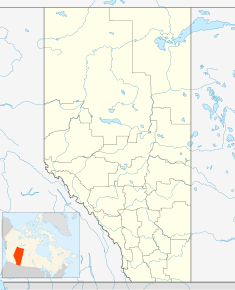Dinosaur Provincial Park
| Dinosaur Provincial Park | |
|---|---|
 Chasmosaurus belli, which was found in the Park, on display at the Royal Tyrrell Museum of Palaeontology | |
| Location | County of Newell / Special Area No. 2, near Brooks Alberta |
| Coordinates | 50°45′42″N 111°29′06″W / 50.76167°N 111.48500°W |
| Area | 73.29 square kilometres (28.30 sq mi) |
| Founded | 1955 |
| Governing body | Alberta Tourism, Parks and Recreation |
IUCN Category III (Natural Monument) | |
| Provincial Park of Alberta | 1955 |
| Type | Natural |
| Criteria | vii, viii |
| Designated | 1979 (3rd session) |
| Reference no. | 71 |
| Country | Canada |
| Region | Europe and North America |



Dinosaur Provincial Park is a UNESCO World Heritage Site. It is about two and a half hours drive southeast of Calgary, Alberta, Canada.
The park is in the valley of the Red Deer River, which is noted for its badland topography. The park is one of the richest dinosaur fossil locales in the world. Forty dinosaur species have been discovered at the park and more than 500 specimens have been removed and exhibited in museums across the globe. The fossil assemblage of nearly 500 species, from microscopic fern spores to large carnivorous dinosaurs, justified it becoming a World Heritage Site in 1979.
Dinosaur Provincial Park Visitor Centre
[change | change source]The Visitor Centre has exhibits about dinosaurs, fossils, and the geology and natural history of the park. There is a video theater, fossil prep lab area, and a gift shop. Public programs are offered in the summer.
John Ware's Cabin is a restored early 20th century cabin that was used by John Ware, an African-American cowboy and important figure in Alberta's ranching history. The cabin is near the visitor center and is open on select days in the summer.[1]
History
[change | change source]The Park was set up on June 27, 1955 as part of Alberta's 50th Jubilee Year. The main aim was to protect the fossil beds. The park was recognised as a UNESCO World Heritage Site on October 26, 1979. Its significant badlands and riverside habitats, and the importance of the fossils found here, were listed as reasons.
Until 1985, discoveries made in the park had to be shipped to museums throughout the world for scientific analysis and display, including the Royal Ontario Museum in Toronto, the Canadian Museum of Nature in Ottawa, and the American Museum of Natural History in New York. This changed with the opening of the Royal Tyrrell Museum of Palaeontology 100 kilometers upstream in Midland Provincial Park. This has a mission to "collect, preserve, research and interpret palaeontological history with special reference to Alberta’s fossil heritage".[2]
Nature
[change | change source]The Park protects a very complex ecosystem with three communities: prairie grasslands, badlands, and riverside cottonwood. Its ecosystem is surrounded by prairies. Choruses of coyotes are common at dusk, as are the calls of nighthawks. Cottontail rabbits, mule deer, and pronghorn can all be seen in the park; the prairie rattlesnake, bull snake and the red-sided garter snake are present as well. Curlews and Canada geese are among the 165 bird species that can be seen in the spring and summer. Some of the most northern species of cactus, including Opuntia (prickly pear) and Pediocactus (pincushion) can be seen in full bloom during the later half of June.
Geology
[change | change source]The sediments of Dinosaur Provincial Park span 2.8 million years and three formations. The terrestrial Oldman Formation is at the base of the strata; the terrestrial Dinosaur Park Formation above, and the marine Bearpaw at the top. The Dinosaur Park Formation, which contains most of the fossils with articulated skeletons,[3] was mostly laid down by large rivers in very warm temperate coastal lowlands. It was on the western margin of the Western Interior Seaway. The formation dates to about 75 million years ago. The Dinosaur Park Formation lasted about a million years.
Paleontology
[change | change source]Dinosaur Provincial Park preserves an extraordinarily diverse group of freshwater vertebrates. Fish include sharks, rays, paddlefish, bowfins, gars, and teleosts. Amphibians include frogs, salamanders, and extinct albanerpetontids. Reptiles include lizards (such as the large monitor Paleosaniwa), a wide range of turtles, crocodilians, and the fish-eating Champsosaurus. Mammals such as shrews, marsupials, and squirrel-like rodents are also there, although usually only noticed by their fossilized teeth, rather than bones.
Mega-plant fossils are rare in the park, but pollen grains and spores collected from here suggest that these forests contained sycamore, magnolia and bald cypress trees, and Metasequoia.
The dinosaurs of the park are astonishingly diverse. They include:
- Ornithomimus
- Struthiomimus
- new ornithomimid species A
- Dromaeosaurus
- Saurornitholestes
- Hesperonychus
- ?new dromaeosaur species A
- ?new dromaeosaur species B
- Troodon
- new troodontid species A
Classification Uncertain
Birds of the Hesperornis type were present, as well as giant Pterosauria related to Quetzalcoatlus. multituberculates, Stagodont marsupials and placental mammals scurried underfoot.
References
[change | change source]- ↑ "Travel Article: Dinosaur Provincial Park". Archived from the original on 2016-03-03. Retrieved 2012-09-06.
- ↑ "Royal Tyrrell Museum". Royal Tyrrell Museum. Royal Tyrrell Museum Cooperating Society. Archived from the original on 2018-10-11. Retrieved 2009-12-14.
- ↑ Skeletons with the bones connected
Related pages
[change | change source]Other websites
[change | change source]- Dinosaur Provincial Park official site Archived 2010-01-10 at the Wayback Machine
- UNESCO World Heritage
